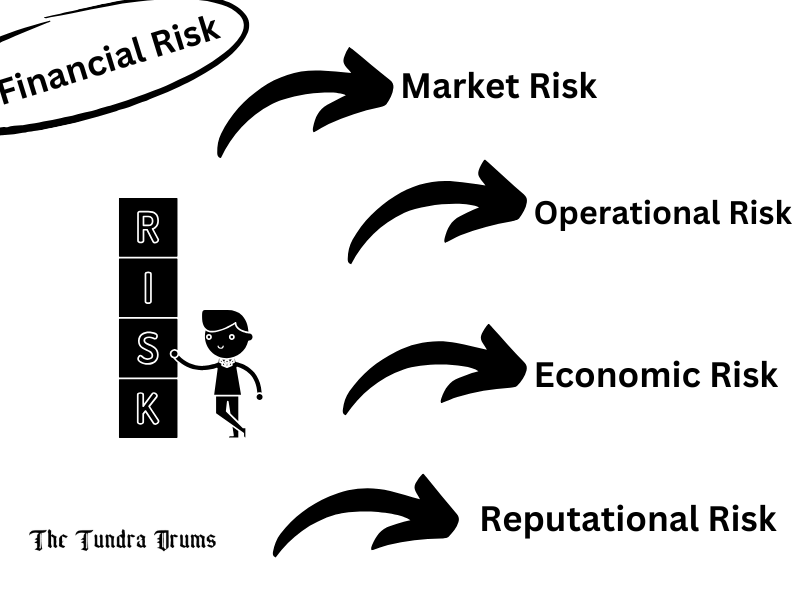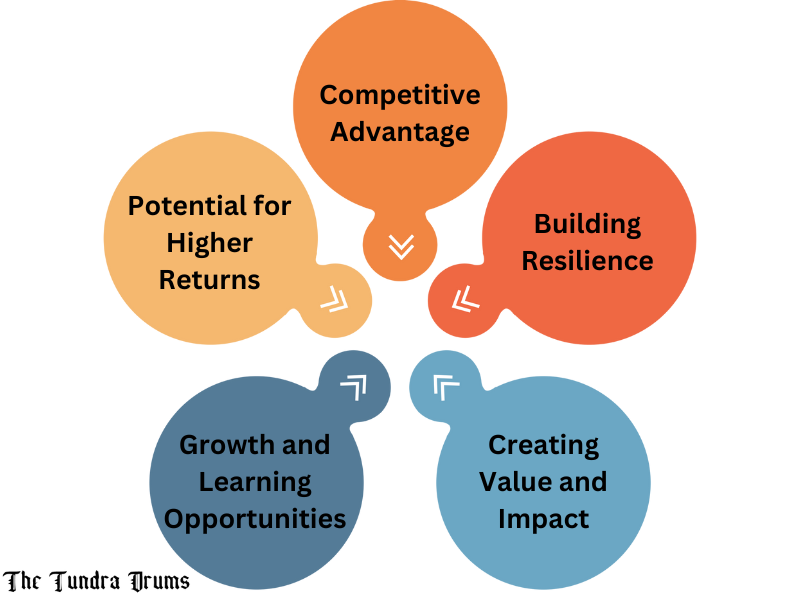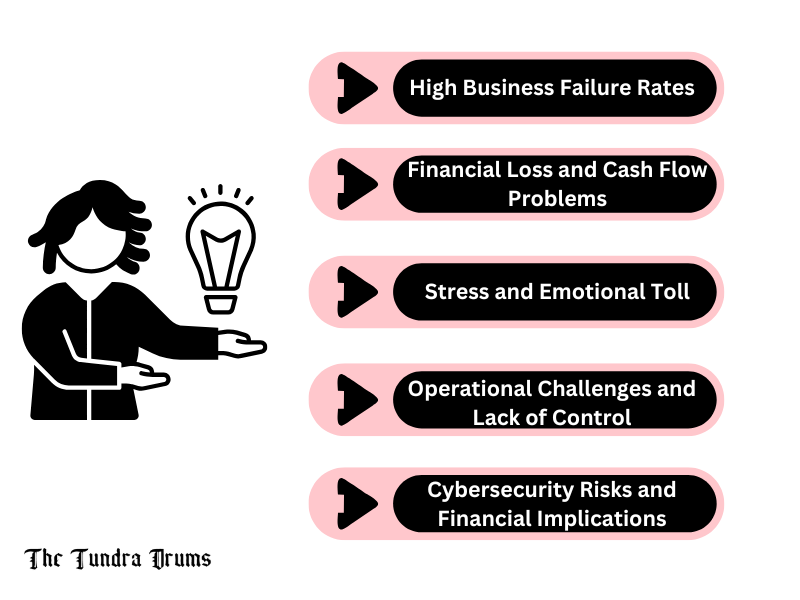Taking risks is part of the DNA of entrepreneurship. If you are dreaming of starting your own business or already in the trenches, you know that risk-taking is inevitable. But what does it mean to take risks as an entrepreneur? And more importantly, what are the good and bad sides to it?
Entrepreneurs face different types of risks, from financial to emotional. Yet, these risks are often the price of entry to achieve something unique and rewarding. Below you will find the entrepreneurial risks and see both the positive and the negative sides, helping you make more informed decisions for your future business.
Types of Risks in Entrepreneurship

1. Financial Risk:
One of the most well-known risks in entrepreneurship is the financial risk. Starting a business requires capital, and there’s no guarantee of return. In fact, statistics show that 70% of entrepreneurial ventures experience financial challenges during the startup process. Additionally, 82% of new small businesses fail due to poor cash flow management within their first five years, highlighting how essential it is for entrepreneurs to master financial planning and management.
2. Market Risk:
Market risk arises from unpredictable changes in the market. For instance, 35% of startups fail because there is no market need for their product or service, and 20% of businesses fail due to an inability to keep up with competition. These stats demonstrate just how necessary market research is for entrepreneurs.
3. Operational Risk:
Operational risks come from within the business, including everything from production issues to logistical challenges. 41% of small business owners express concerns about losing control over their business processes, which underscores the importance of strong management practices. For e-commerce businesses, the average cart abandonment rate is over 80%, indicating a substantial risk in converting customer interest into actual sales.
4. Reputational Risk:
Your reputation is key to maintaining trust and credibility. In today’s era, cyber risks are particularly pressing. In 2024, 40% of risk management experts identified cyber incidents as the most significant risk for businesses, with financial implications reaching into the billions. As of 2023 about 350 million individuals were affected by record exposure. As a result, many insurers are now offering specialized cybersecurity policies to help businesses protect against these modern-day threats.
5. Economic and Environmental Risks:
External factors like economic downturns or global crises can significantly impact businesses. For example, during the COVID-19 pandemic, 41% of startups globally reported having only three months or less of cash runway, illustrating the devastating impact unexpected events can have on cash flow.
Entrepreneurs’ Perception of Risk in the Business
For entrepreneurs, risk isn’t something to avoid; it’s something to handle wisely and sometimes even welcome. How entrepreneurs see risk can vary:
- Some see it as a challenge or a necessary step to reach success.
- Others treat it as a careful bet, where the possible rewards are worth the risk.
Taking a calculated risk in business can make all the difference. Instead of jumping in without a plan, successful entrepreneurs:
- Look at possible outcomes and consider the pros and cons.
- Focus on making smart choices that help their business grow.
This approach isn’t about avoiding risk it’s about taking risks that make sense and add value.
The Good Sides of Taking Risks as an Entrepreneur

1. Potential for Higher Returns:
Taking risks often means stepping into uncharted waters. However, with risk comes the potential for greater rewards. When you enter a market early or try a new idea, you might be the first to reap the benefits.
2. Growth and Learning Opportunities:
Each risk taken provides a learning opportunity. Even if things don’t go as planned, the experience gained is invaluable. Many entrepreneurs say that every risk, successful or not, helped them grow both personally and professionally.
3. Competitive Advantage:
Taking calculated risks can set you apart from your competitors. By innovating or adopting a bold approach, you can position your business uniquely, giving it a competitive edge.
4. Building Resilience and Confidence:
Risk-taking builds resilience. The more risks you take and challenges you overcome, the stronger and more confident you become as an entrepreneur. This stability is crucial to understanding the ups and downs of business life.
5. Creating Value and Impact:
Entrepreneurs often take risks to bring something new to the market, creating value for customers. This can be incredibly fulfilling, as you’re not only making money but also making a difference.
The Bad Sides of Taking Risks as an Entrepreneur

1. High Business Failure Rates:
Statistics reveal that 20% of new businesses fail within their first two years, and 49.7% shut down by the five-year mark. Over ten years, up to 65% of businesses will close their doors. This high failure rate highlights the inherent risks of entrepreneurship and the critical need for careful planning and research.
2. Financial Loss and Cash Flow Problems:
One of the biggest risks of becoming an entrepreneur is the chance of financial loss. Cash flow issues are particularly common, with 82% of businesses failing due to cash flow challenges. Additionally, 29% of startups fail simply because they run out of funding, emphasizing the need for strong financial planning.
3. Stress and Emotional Toll:
Risk-taking in entrepreneurship can be stressful. Constantly dealing with uncertainties can lead to anxiety and burnout, impacting both your mental and physical health. Studies show that 40% of adults feel apprehensive about starting a business due to fear of failure a fear that is even more pronounced among certain groups, such as 63% of women in the UK.
4. Operational Challenges and Lack of Control:
Maintaining control over operations can be challenging. About 41% of small business owners express concern about losing control of their business processes, which can affect the efficiency and stability of their business.
5. Cybersecurity Risks and Financial Implications:
The rise in cyber threats poses a substantial risk to businesses today. The U.S. D&O liability insurance market is expected to exceed $20 billion by 2030 due to the need for protection against cyber incidents. These threats carry a heavy financial burden, making cybersecurity a top priority for entrepreneurs.
Final Words
Taking risks is part of every entrepreneur’s journey. The rewards can be life-changing, but the stakes are equally high. By understanding the types of risks in entrepreneurship and the entrepreneurs’ perception of risk in the business, you can approach each challenge with eyes wide open.
Remember, not all risks have to be taken. Calculated risks, where you consider the potential outcomes and prepare for different scenarios, are often the wisest path. At the end of the day, every decision you make as an entrepreneur should align with your vision and values.
FAQs
1. What are the common types of risk in entrepreneurship?
Common risks include financial, market, operational, personal, and reputational risks.
2. Why do entrepreneurs take risks?
Entrepreneurs take risks to innovate, achieve higher rewards, and create value. They understand that without risk, there’s little chance of significant growth.
3. How can entrepreneurs manage financial risk?
Financial risk can be managed through thorough planning, budgeting, and keeping a safety net. Calculated investments are also key.
4. What is a calculated risk in entrepreneurship?
A calculated risk is one where an entrepreneur assesses the potential outcomes and prepares for challenges, rather than jumping in blindly.
5. Is taking risks as an entrepreneur always worth it?
Not always. Each risk should be considered carefully to determine if the potential benefits outweigh the possible downsides.











